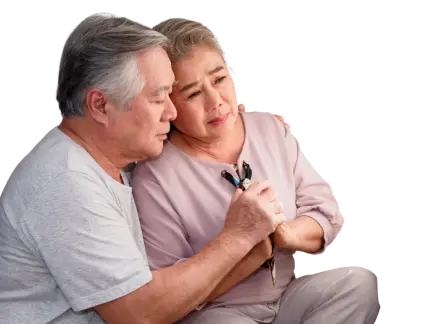Pedestrian Accidents in Missouri
Imagine you’re standing at a crosswalk, waiting for your turn to walk across the busy intersection. The pedestrian light turns green, and you step off the curb after looking both ways. Out of nowhere, an SUV takes a sharp right turn at the corner and hits you. Suddenly you are lying in the street, injured, in shock, and disoriented. Do you know what to do?
According to a recent report from the Governors Highway Safety Association (GHSA), although overall traffic deaths declined by 6 percent over the 10-year study, pedestrian fatalities increased by an incredible 35 percent over the same period. And the statistics for Missouri—particularly the St. Louis area—are comparable. According to the GHSA report, in 2018, Missouri ranked 20th in the nation for the highest number of pedestrian fatalities—44—during the first six months of the year.

What Are the Common Causes of Pedestrian Accidents?
According to the GHSA study, two significant contributors to pedestrian fatalities are distraction from cellphone use and the increased market-share of SUVs on the road. Both drivers and pedestrians are increasingly distracted when using their cellphones and become unaware of their surroundings and potential dangers. Also, the chances of a pedestrian surviving a pedestrian-vehicle accident are significantly lower when the pedestrian is struck by an SUV compared to a standard car. The number of new SUVs on the road compared to new standard-sized cars has increased every year since 2013.
Other common causes of pedestrian-vehicle accidents include:
- Driving Under the Influence (drugs or alcohol use)
- Poor weather conditions
- Failure to yield
- Improper use of lanes
- Right-turn accidents
These accidents usually occur because one of the parties—either the pedestrian or the driver of the vehicle—is negligent.
If you have been struck by a vehicle and injured while you were a pedestrian in the street, crossing the road, or walking on the sidewalk, you can recover for any damages you suffered as a result of a driver’s negligence.
Contact our Kansas city personal injury lawyers now.

What Should I Do at the Scene of a Car Accident?
What you do immediately after a pedestrian accident will determine how quickly and easily you may recover from your accident—both physically and financially. If you are able, here are several steps to take immediately after your accident to ensure your safety and your ability to recover for any damages that a negligent driver may have caused.
Move to a safe place
The most important thing you can do is make sure that you’re in a safe place. If you are unconscious or severely injured, your ability to move to a safe place will be limited. However, if you are able to do so, move out of the path of traffic to avoid any further injury.
Call 911
Once you are safe, call 911 and report the accident. The dispatcher will send a medical team and a police unit to the scene. Even if you think your injuries are not significant enough to require medical attention, stay at the scene until the medical team and police arrive. You should be evaluated by the medical team and make a full report to the police. Once that report is filed, make sure you receive a copy of it for your own records.
Exchange information
Try to make sure that the driver also stays at the scene until the police arrive. Ask to exchange insurance and contact information with the driver. The driver may want to leave if they think your injuries are not significant. Don’t agree to let the driver leave, even if they provide you with insurance and contact information. If the driver refuses to stay, use the camera on your phone to take pictures of the driver, the car, and the license plate to provide to the police. A driver who hits someone and then drives away before the police arrive is a hit-and-run driver and subject to criminal charges.
Gather evidence
If any witnesses saw the accident and have stopped, ask them to stay and give their statements to the police. Also take pictures of the car that hit you, the driver, and the surrounding area. Especially note if there were any street signs or traffic signals nearby that the driver may have ignored. If the driver is being uncooperative and tries to leave, these witnesses may be able to help you secure the license plate or any other identifying information or other evidence that may be relevant to your case.
You can document this information as you wait for the police. Try to document as thoroughly as possible, including:
- Your injuries
- The vehicle that hit you
- The driver of the vehicle
- The surrounding area
- Any evidence such as skid marks or inoperative lights or turn signals on the vehicle that hit you
The best way to document evidence is through photographs that you can then keep on your phone and provide to the police, the driver’s insurance company, and your lawyer.

How Do I Hold the Driver Who Hit Me Responsible?
Once you have documented all of your injuries and related expenses and you understand what kinds of compensation you might be able to receive, it is time to take action that will hold the driver responsible for your injuries, pain, and suffering.
You may be able to press criminal charges against the driver. If you press criminal charges, the driver may receive a prison sentence or a heavy fine. However, pressing criminal charges will not provide you with financial recovery. To recover the costs for the damages you sustained, you also will need to file an insurance claim or a civil lawsuit.
When deciding how to recover your costs, the best thing you can do is consult with an attorney. Pedestrian accidents can be complicated, and an insurance company is probably not going to offer you an initial settlement that actually covers all of your damages. You may be able to negotiate with the insurance company on your own behalf to get a better settlement, but insurance companies are experts at settling claims for less than what they could be worth. You should always let an experienced attorney negotiate with the insurance company after an accident in which you sustained injuries.
An attorney will be able to assess your situation based on the facts of your case and the laws in your state. The attorney will then be able to recommend the best course of action for you to take. Whether you pursue an insurance settlement or a lawsuit, an attorney will best be able to advocate on your behalf to get you the best possible result in your case.




